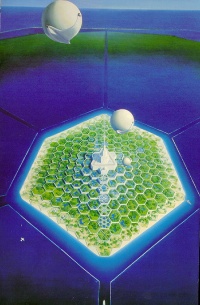Thaumas Program
From GURPSworld Wiki
The Thaumas Program is a massive joint undertaking by Azimuth, Datalite, and Halon to colonize the world's oceans. Two such colonies are currently under construction, and two more are in the planning stages. Thaumas I, located in the vicinity of Kiribati, is already inhabited, and is scheduled to be completed within a year. Thaumus II, in the Indian Ocean near The Maldives is scheduled to be completed within two years. The total projected cost for the Thaumas Program is in excess of $500 billion, though the colonies are designed to be self-sustaining once they are completed. All Thaumas Program sites are within 0.5 degrees of the equator. This serves to both minimize storm risk and maximize available solar energy.
Design and Operation
The Thaumas Program colonies represent the pinnacle of engineering technology and innovation. Each colony is hexagonal in shape, and is approximately seven miles across. The outer edges of the colonies comprise breakwaters, designed to shield the interior pools and the innermost habitation zone from the forces of the ocean. These are designed to approximate natural beaches, complete with sand dunes and natural foliage. Fruit trees, vegetables, and open parkland are found in the interior of the breakwater ring. At the heart of each colony is its ocean thermal energy conversion engine, or OTEC, which, along with solar materials integrated into the surface structures, power the station. Additionally, the OTEC serves to bring nutrient-dense, cold water from the depths of the ocean to interior pools of the colonies. These pools are used to grow blue-green algae and other marine organisms, to be used as food for the inhabitants.
Azimuth estimates that a fully-operational colony will generate approximately 1.4 gigawatts of power and will only consume 190 megawatts of power to operate, for a surplus of 1.21 gigawatts. The Thaumas Program plans to store the excess energy in enormous molten salt batteries, and to wire the colonies to nearby islands, from which the power can be further distributed. None of the three corporations has commented on what uses it has for the excess power. Azimuth further predicts a food surplus on each colony, and has announced that extra food is earmarked for humanitarian aid to underdeveloped societies near the colonies.
The Habitat
The living space within the colonies, which is the innermost portion of each unit, is designed to house as many as 100,000 people. Unlike traditional building practices used for terrestrial construction, the habitats of the Thaumas colonies are composed of materials accreted from seawater onto a steel and aluminum frame. The accretion is achieved by way electrical induction, causing minerals to accumulate on the metallic frame in patterns and shapes both organic and as specified by sophisticated computer modeling. The result is a smooth, seashell-like concrete formed from sea minerals. Large air pockets are set into the structure throughout its base to improve buoyancy.
The habitation zone of Thaumas colonies comprise many parks, ponds, submerged facilities, homes, communal spaces, work spaces, and other amenities all situated upon a terrace of hexagonal layers. At its center, the structure rises in a spire to a height of over a fourteen-hundred feet above sea level. The transitions between indoor and outdoor spaces are natural and flowing, with lush vegetation and fresh water to be found in abundance. Throughout the colony, residents enjoy the latest in technological innovations, complete with access to the internal supercomputer mainframe, world class healthcare facilities, schools, and the most sophisticated scientific facilities in the world. Each Thaumas colony is a living, breathing city, with nature and technology merged together to give inhabitants the highest quality of life.
Technology
The Thaumas Program is reputed by its builders to include the latest in energy, communications, computing, and defense technology, as would be expected by a program launched by Azimuth, Datalite, and Halon. The corporations insist that the Thaumas Program represents the pinnacle of human technological achievement, and that the future of humankind's scientific research will be centered within the colonies. Datalite representatives have stated that the colonies are outfitted with the Echo Three supercomputers, and that all of the colonies will be integrated with each other, and with Datalite's satellite network.

